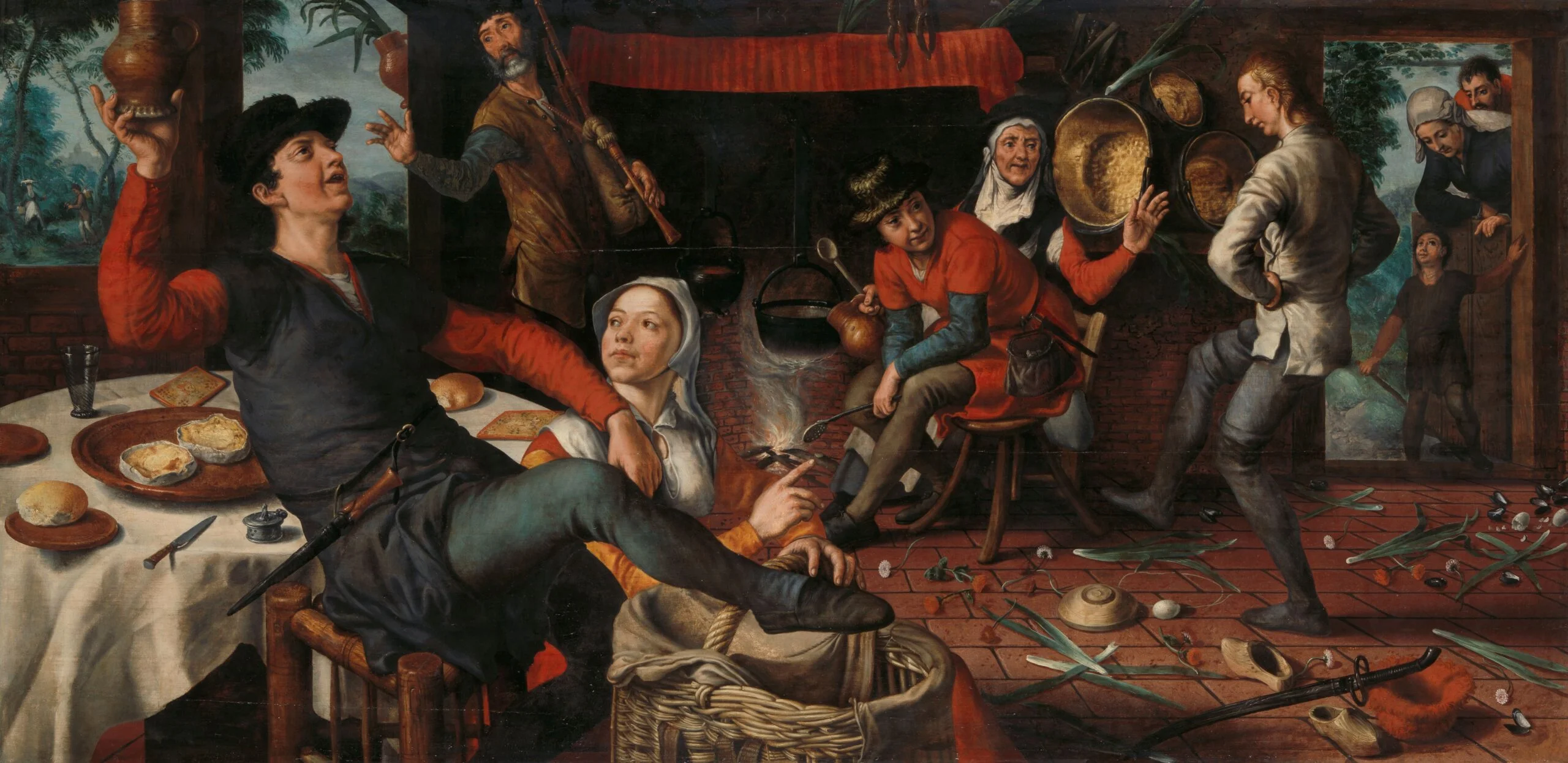
Own your version and make up the origins story and a death – or an ending story – for your Batman.
Grant Morrison
That is what Grant Morrison (The Invisibles, Arkham Asylum, All-Star Superman) once said to Scott Snyder (American Vampire), as one writer of Batman to another. To have a proper grasp of the character, knowing how his story starts and finishes seems almost necessary. These are words that influenced also another well-known Bat-writer, Tom King (Mister Miracle, Vision). However, it was certainly Frank Miller‘s most important works on the character that inspired Morrison and the others: Year One and The Dark Knight Returns.
When it comes to iconic characters like the Bat, taking the reins of his story is of course a daunting task, but also a highly stimulating one. This idea of telling the origins of, and at least the symbolic death stories of Batman, has also made its way also into the movie adaptations, like Christopher Nolan’s trilogy shows. On the occasion of the Bat’s 82nd birthday, it seems appropriate to analyze how four different comics writers left their mark by telling their version of the origins and the death of Batman. (Spoilers ahead)
Superheroes revisionism: Frank Miller’s origins and death stories on Batman
Frank Miller’s origins and death stories of Batman came out in 1986. The settings of both Batman: Year One and The Dark Knight Returns settings mirror the contemporary USA and show flawed and tormented characters. They are emblematic of the so-called superheroes revisionism, which focused on more mature and realistic contents.
In Year One, a young Bruce Wayne finally comes back to Gotham City after years. What awaits him is a muddy, dark and unwelcoming city, as drawn by David Mazzucchelli, where crime and corruption have taken over.
Miller wisely puts Bruce against corrupted cops and mobsters, without relying on spectacular villains. This Batman in-the-making has to deal with the true face of Gotham, the one which relies on illegality without seeing any other recourse. Though, before he can become the city’s new hope, Bruce must convince himself he is up to the job. For the first time, we see Batman making rookie mistakes and being uncertain of what to do. Nevertheless, with one try after another, he tests and learns all his characteristic tricks, becoming the hero Gotham needs.
The Dark Knight Returns: a good death or a good life
This story can be considered both an ending and a new beginning for Batman. Despite the nihilistic feeling all characters give, the comic points to the rise of a new hope. The first chapter starts with a suicidal touch, with Bruce Wayne trying to get himself killed in a dangerous car race. It would be a good death, he says to himself, but not good enough. After hitting rock-bottom, his return starts to build up. To be Batman once again, though, is both a redemption and a curse.
As a symbol of hope for Gotham, Batman cannot keep on keeping quiet while he sees his city at a loss, without a moral benchmark. He fights to show that it is necessary to fight for a change, especially in the darkest hour. Even if it means going against the principles of law and order and breaking some rules.
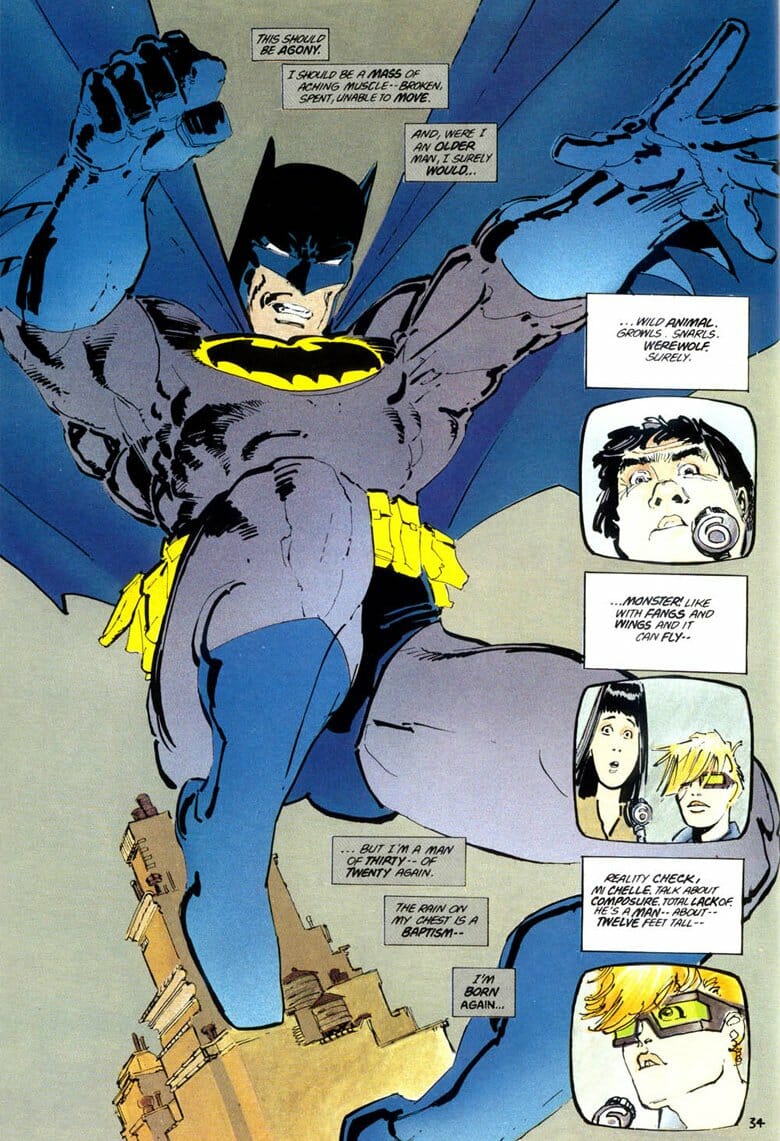
However, morality is not all that drives Bruce. As though under the effect of a withdrawal syndrome, he wears the Bat-cape once again because he needs it. The thrill of the fights and even the deadly risks are part of being Batman too. At least partially, Bruce probably wants to take his last breath while he tries to fulfill his utopian mission of pushing crime back for good.
Anyway, Miller’s Batman is mostly a symbol that can show a different future to the younger generations. Thus, after a long-expected fistfight between Batman and Superman, the story ends with Bruce faking his death, while actually training a new generation of heroes. This will be a good life, he says. Good enough.
Grant Morrison: Bat-Man vs. Bat-Myth
Grant Morrison, passionate about the history of the character, decided to integrate all the adventures of the Bat in his run, from 1939 to the present day. Thanks to multiple expedients, he uses the stories of the previous decades as background for his storyline. A choice similar to that of Alan Moore‘s one in Miracleman, which somehow includes Mick Anglo’s stories of the 50s. Maybe the most intriguing integration is the Batman of Zur-En-Arrh, which originally appeared in a 1958 story as a Batman from an alien planet. Morrison makes him a latent personality in Bruce Wayne’s mind, a sort of back-up Batman made through mental training, which comes into play in case Bruce is psychologically attacked or suffering from amnesia.
In his peculiar interpretation of Batman, Morrison reverses the narration of the beginning and end. His concluding story of the superhero takes place during the maxi-event Final Crisis. Darkseid attacked the Earth and this time he won. Bruce Wayne has been kidnapped and kept under mind control, while two of Darkseid’s creatures steal his memories to create clones of him. It turns out that the clones, once awakened, go mad with pain and decide to commit suicide. Only Bruce Wayne can bear the pain and burden of being himself. This is why he is special.
The fire burns forever
Once free, Batman goes to his final confrontation with Darkseid. He defeats him using a gun loaded with a bullet capable of killing the gods. That’s the only time Batman used the gun, the only time he made an exception to the rule of never using the weapon that killed his parents. Darkseid simultaneously hits him with his Omega Sanction, apparently killing him.
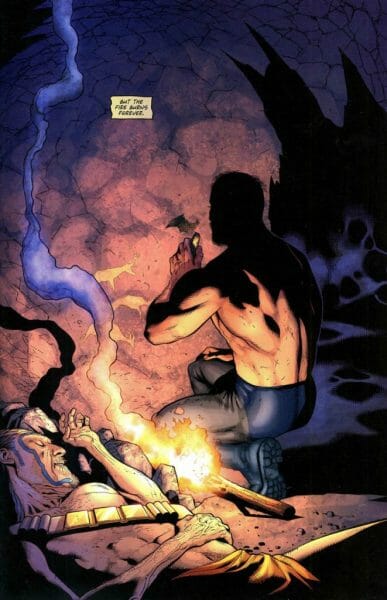
After this, comes the beginning. What Darkseid actually did was to send Batman back in time. It all starts with an amnesiac Bruce Wayne in a cave in prehistoric times. He is drawing the sign of a bat on the walls of what in the future will be the Bat-Cave. Thus begins an odyssey through different eras, as Bruce travels through time thanks to the Omega energy. Different versions of Batman take life throughout the centuries, creating his own, everlasting myth.
Snyder’s and Capullo’s Batman: It all started with a red hood…
After Grant Morrison’s run on Batman, Scott Snyder and Greg Capullo took over with the beginning of The New 52. In these episodes, both the origins and death stories of Batman are tied to the Joker. They are complementary and it almost seems their birth and demise are inevitably connected. It is true that they also wrote a dedicated graphic novel to a supposed conclusion of Batman, Batman: the last Knight on Earth. However, here let’s focus on their run, which builds a consistent and complete story arc.
In their episodes, the fight between Batman and Joker strongly revolves around their different views of Gotham City. Both at the beginning and the end (respectively in Zero Year and in Endgame), Batman believes Gotham is a hard place to live in, but that it also pushes people to be better. The Joker is a nihilist instead, always trying to prove that Gotham is a place where evil strikes with no reason and always will.
Since Batman is bonded to the Joker, Snyder chooses him as a test-bed in his origin story. Recalling Moore’s The Killing Joke, the Joker is originally a Red Hood, even if in this case he is the mastermind of the group instead of a failed actor. He carries out apparently random attacks to spread chaos and fear around the city. Batman chases him down until the famous showdown at Ace Chemicals, when the Red Hood falls into the tank of green chemicals and the endless fight between the bat and the jester begins.
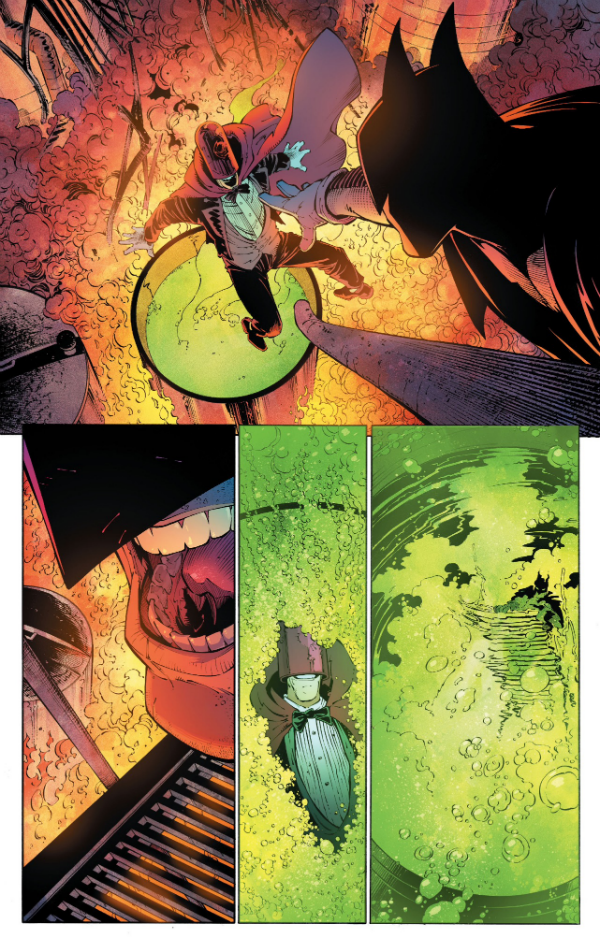
…And ended with a pale jester
The fight for the soul of Gotham finds its conclusion in Endgame, initially meant to be the ending of Snyder’s episodes. Batman has to face a Joker who is no longer interested in playing games and is strangely motivated to kill him once and for all. He pushes Gotham to the brink of destruction thanks to a new version of his venom, which turns love into hate.
The investigation to find an antidote leads Batman to believe Joker is some kind of evil being, the Pale Man, who always lived in Gotham (and is almost the equivalent of Morrison’s ever-existing Batman). Bruce faces his worst fear, namely that the Joker is not just a man who can be defeated, but is an evil and unstoppable force. The last discovery, though, shows that evil is not at all eternal, and the Joker with it, and it is possible to fight them back.
Batman succeeds in stopping his nemesis but the battle costs the lives of them both. Like his life, also Batman’s death is a symbol. Maybe he could have found a way to survive, even to become immortal. But he decided not to, as the butler Alfred suggests, because he always wanted the people of Gotham to see him as one of them, as a normal person. Like many other Gothamites, Batman was just one who fought to prove people like the Joker are wrong and there’s always hope for a better tomorrow. After all this, Snyder brought Batman’s tale further, but this is another story.
Tom King: Man vs. Bat
If someone would decide to graph Tom King’s Batman run, a sinusoidal shape would come out. A wave with repeated ascents and descents. King makes Bruce Wayne touch absolute happiness, approaching the fateful wedding. Then, he shatters that dream into a thousand pieces and with it the psyche of the Bat. At the center of this run, there is Selina Kyle, Catwoman, perhaps the true protagonist of the story, and her love story with Batman. A detective and a thief who since the first meeting have staged an eternal chase. It is no coincidence that both the origins and the death of Batman, according to Tom King, revolve around the figure of the thief.
In King’s beginning, The War of Jokes and Riddles, Bruce tells his darkest secret to Selina. A young Batman is in the middle of a war between the Joker’s and the Riddler’s gangs, a war that costs the lives of many. At the end of this grueling battle, he finds himself in a room with the Riddler and the Joker. Batman, with a heart weighed down by the death of a child, decides to kill the Riddler attacking him with a knife. It’s the Joker’s hand that stops him. There, for the first time in the entire run, Joker bursts out laughing. In some ways, Bruce is no different from them. Somehow the line that separates Batman from assassins and criminals is shaped like a white hand.
Bruce needed Selina to know all this. She had to be aware of Batman’s biggest secret to accept him wholly. And she does. With no more masks and secrets, the detective and the thief are ready to swear eternal love.
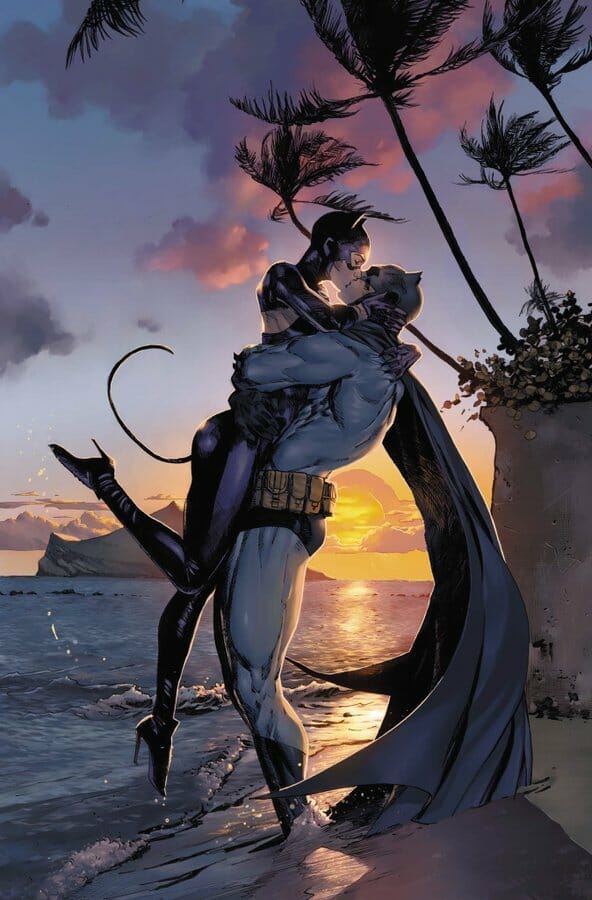
A thief, a detective, a love story.
King’s Batman is perhaps the most human of all, worried by his limits and his mortality. What will happen to Gotham when he is gone? Will it be just a small interlude of goodness in an eternity of murder and depravity? And mostly: is Batman allowed to be happy? Can he do what he does without the guilt and the sadness rooted in him since childhood?
The relationship with Selina brings out all these questions. She knows him in both guises, the Bruce-mask and the soul of the Bat. In the most terrible moments, when the limits of the body seem to have taken over the Dark Knight, it is Selina who reminds him of his commitment.
King tells his character ending in Batman Annual 002, telling of several encounters of the detective and the thief. The story goes up to a possible future when Bruce and Selina are old and married, with a daughter who has taken the legacy of Batman. The best detective in the world and the most skilled thief are united together against the inevitability of time. Bruce is sick, but he can’t accept it and Selina helps him in maybe the most difficult time of all. The comic begins with a very young Catwoman who manages to steal the Bat-Mobile and ends with her old, alone, who finds a posthumous ticket in the same machine. There is no need to steal the car this time, she has already stolen his heart. Selina smiles, turns on the car, and runs into the night.
A never ending story
Batman was created in 1939 by Bob Kane and Bill Finger but even they could not imagine that they had created a legacy to be passed on from author to author. Although the original core of Batman remains untouched, each author expands and deepens it. Superheroes are new archetypes, protagonists of modern mythologies always interpreted from multiple perspectives. Characters evolving throughout time, while remaining consistent.
The analysis of these origins stories shows a map built day after day like a mosaic. Batman is a narrative cosmos composed of movies, cartoons, and – obviously – comics that influence each other. The authors’ endings, on the other hand, show how these immortal stories will always find a way to start over. As long people will need inspiration, superheroes like Batman will always be there.


